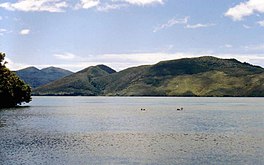Lake Rotoaira
| Lake Rotoaira | |
|---|---|
 Lake Rotoaira | |
 | |
| Location | South of Lake Taupō on the North Island Volcanic Plateau, Taupō District, Waikato region |
| Coordinates | 39°03′16″S 175°42′51″E / 39.0545°S 175.7143°E |
| Lake type | natural lake |
| Primary outflows | Poutu Stream and Tokaanu Tunnel |
| Basin countries | New Zealand |
| Surface area | 13 km2 (5.0 sq mi) |
| Max. depth | ca. 14 m (46 ft) |
| Surface elevation | 564 m (1,850 ft) |
Lake Rotoaira (sometimes written Lake Roto-aira) is a small lake to the south of Lake Taupō on the North Island Volcanic Plateau in New Zealand. It covers an area of 13 km2.
Lake Rotoaira is one of the few privately owned lakes in New Zealand being administered by the Lake Rotoaira Trust on behalf of its owners. An access permit must be held by those using the lake for fishing and similar activities.
The lake is located in a graben between the broad volcanic dome of Mount Tongariro to the south and the smaller volcanic peak of Pihanga to the northwest. It is naturally drained by the Poutu Stream into the Tongariro River.
The Tongariro Power Scheme utilises Rotoaira as a storage lake for the Tokaanu Power Station.[1][2] Extensive engineering works were carried out between 1964 and 1971 diverting a number of streams (including Whanganui River) into Rotoaira via Lake Otamangakau and construction of a tunnel through Pihanga to the Tokaanu Power Station.[3] The lake originally drained into the Poutu Stream but when the Poutu Dam was constructed the lake level was raised by about 50 cm.[4] Motuopuhi Island was formerly a peninsula but became an island when the water level was raised by the Tongariro power scheme.[5] Motuopihi was the hiding place of Te Rauparaha and where he composed the Ka Mate haka.[5]
Opōtaka, a traditional site of Māori occupation, is situated on the northern shore of the lake. Of significance to iwi Ngāti Tūwharetoa and Ngāti Hikairo it was excavated during archaeological investigations on the Tongariro Power Scheme and was found to have been occupied in the 19th century.[6][7] In 2022 Ngāti Hikairo received funding to restore Opōtaka.[8]
In 2021 the Lake Rotoaira Forest Trust received funding from the government's Jobs for Nature programme to remove invasive plants and animals from around the lake, particularly in the lake's wetlands.[9]
References
[edit]- ^ McKinnon, Malcolm (2015). "Volcanic Plateau places - Tongariro area". Te Ara. Retrieved 31 October 2023.
- ^ "Tongariro Power Scheme | Genesis NZ". www.genesisenergy.co.nz. Retrieved 2023-10-26.
- ^ Martin, John E., ed. (1998). People, politics and power stations: electric power generation in New Zealand 1880-1998. Wellington, NZ: Electricity Corporation of New Zealand. pp. 220–234. ISBN 978-0-908912-98-8. OCLC 931064862.
- ^ Lake Managers' Handbook: Fish in New Zealand Lakes (PDF). Wellington: Ministry for the Environment. 2002. ISBN 0-478-24069-4.
- ^ a b "Motuopihi Island". Te Ara - the Encyclopedia of New Zealand. 2017. Retrieved 31 October 2023.
- ^ "An introduction to Opotaka". Heritage New Zealand visitheritage.co.nz. Retrieved 2023-10-31.
- ^ Walton, Anthony (July 1994). "Settlement at Opotaka". New Zealand Historic Places. 48: 39–41. ISSN 0114-9172.
- ^ Ellis, Moana (2022-03-23). "Historic site restoration a boost for tribe's emotional connection to the land". Stuff. Retrieved 2023-12-02.
- ^ "Tackling Tongariro's biodiversity threats". beehive.govt.nz. 15 November 2021. Retrieved 15 November 2023.
Further reading
[edit]- Lecointre, Neall, Wallace and Elliot (2004). Late Quaternary evolution of the Rotoaira Basin, northern Tongariro ring plain, New Zealand, New Zealand Journal of Geology & Geophysics, Vol. 47, 549–565.

